Introduction to Inclusive Leadership
Training to build the foundation of a diverse, innovative, and productive workplace culture.Today’s leaders must be able to effectively communicate and build trusting work relationships with many different kinds of people. We are moving from the era of “command and control” to an era of “engage and include.”

Some individuals have a natural ability to feel comfortable with many different types of people and can easily build camaraderie within their teams. Others are comfortable exhibiting inclusive behaviors themselves but have difficulty coaching and developing these skills among those who report to them. And still others have difficulty establishing comfortable working relationships with specific people or groups.
According to the Gallup Organization, disengaged (exclusive) managers are three times
more likely to have disengaged and actively disengaged employees, costing businesses
billions of dollars in lost revenue each year. If you are working to create a culture that values all employees and is inclusive of differences, your leaders must understand what inclusion is, how it is achieved and what specific behaviors and actions they can take to promote the culture you desire.
Inclusity’s Introduction to Inclusive Leadership Workshop (or series) provides your supervisors, managers, and leaders the personal insight and awareness, knowledge and skills they need to become the best and most inclusive leader possible.
In this four-, eight-, or 12-hour workshop (or series of shorter workshops if desired) we introduce your leaders to up to four Inclusity Models and the tools they need to actively become inclusive leaders.
Learning Objectives:
- Participate in and lead small group discussions about the factors that define their team members, in order to build trust and open communications
- Understand the attitudes and behaviors that create exclusion
- Identify situations in which team members are being excluded
- Increase their commitment to actively include instead of unintentionally excluding
- Utilize models presented during the training to intentionally create more inclusive workplace teams
From The Inclusity Blog
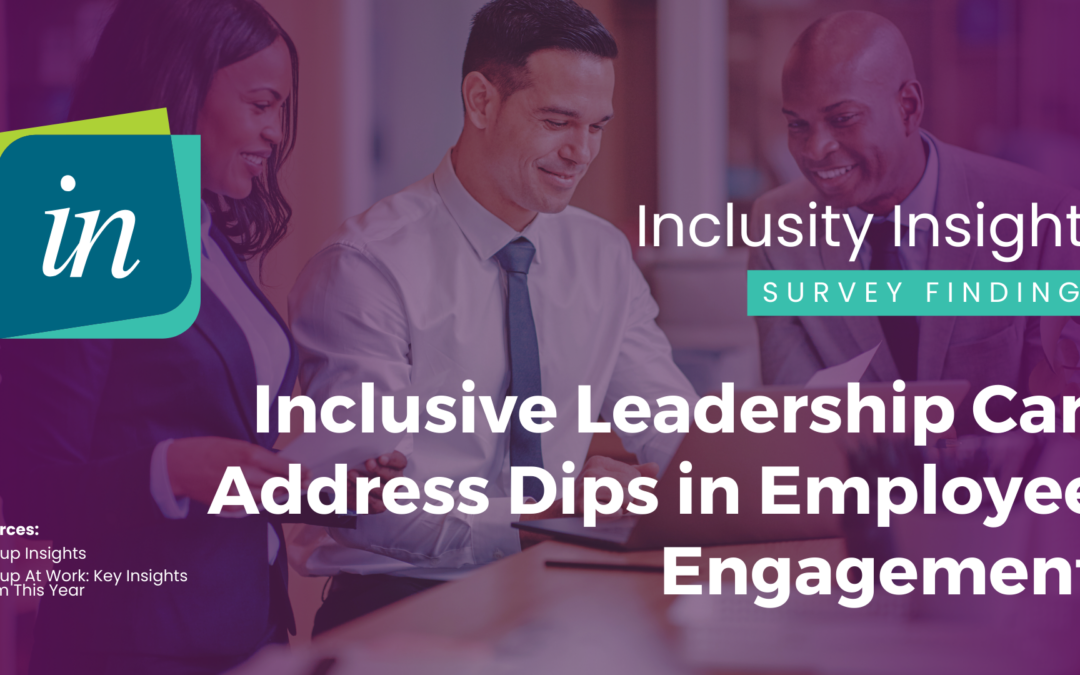
Inclusive Leadership Can Address Dips in Employee Engagement
At Inclusity, we closely follow workplace trends regarding employee engagement. It’s more than just curiosity; it’s part of our mission to help organizations create environments where employees engage. Gallup shared data in January that indicates that engagement stagnated, despite a slight bump in early 2023. Only 33% of U.S. employees are engaged in the workplace, with less than half being fully engaged. A problem for the obvious reason that it cost the economy $1.9 trillion in lost productivity, it also signals a longer-term issue.
The Post-Covid Workplace
Engagement and productivity have been steadily declining since (you guessed it) 2020. While some may believe that the pandemic and its impact are behind us, Gallup’s survey results say otherwise. The impact of Covid-19, and the way it changed the ways we work together may have dramatically influenced our workplace cultures for the foreseeable future.
Because our work focuses on building cultures of inclusion where all employees can fully engage, addressing the challenges of the post-Covid workplace is a critical part of the equation. Looking at the factors that contribute to engagement (or lack thereof) will help us to understand.
Employees’ sense of “role clarity” has been declining since 2020. Gallup reports that only 41-47% of employees surveyed responded positively to the question, “I know what is expected of me at work.” We might think it’s “remote” workers who led this dip, but, interestingly, it was hybrid workers who came in at the lowest percentage here.
Gaps in Communication
The largest factor contributing to the decline of role clarity lies in the lack of consistent feedback and meaningful communication. The extent to which employees have experienced meaningful feedback in the past week correlates with their engagement. According to Gallup, the most important thing a manager can do to keep their employees engaged is to have at least one meaningful conversation with them every week. This seems so simple, yet why do so many of us find it so difficult?
Time (not enough of it!) challenges our capacity, and managers are feeling the time crunch even more. Of all managers Gallup surveyed in 2023, 64% reported taking on significant additional responsibilities in the previous 12 months. Because managers are rarely asked to report on the amount of time they spend with their people, it’s not surprising that this activity can fall by the wayside as other responsibilities take priority. And spending time in what could be perceived as “chatting with my folks,” could even seem like a waste of time or much less important than other business priorities.
Beyond taking the time out, many managers don’t feel comfortable “chit chatting” with their direct reports. When I was trained as a manager in the 1980s, I was instructed to avoid personal conversations at work and to completely avoid topics related to race, gender, and other elements of individuality that are important to employees. Through Inclusity’s work, we’ve observed that most managers are uncomfortable discussing these subjects and so they avoid them altogether. And when they do this, they can come off as being distant, uncaring, unapproachable, and disengaged.
When employees aren’t even in the same building, the potential for conversation becomes more challenging. According to the Gallup report, 70% of all managers report never having had any training in how to lead a hybrid or remote team. We know that “management by walking around” is difficult enough; how do we as managers communicate that we care through a computer screen? Especially if we haven’t invested in building personal relationships in-person first.
How a Leader Can Connect
This may seem intimidating! But let me tell you that we have some tips for you, and, better yet, we know that they work!
- Make it meaningful. Gallup mentions that meaningful conversations “include recognition and discussion about collaboration, goals, and priorities, and the employee’s strengths.” I would also propose that meaningful conversations include topics that the employee cares about!
Every single employee is different, and they all value different things. One person wants to talk about ideas, another about movies they have seen, and yet another about their family. Some of my direct reports are not super talkative, but they always ask me how I am doing. They seem to enjoy when I share the trials and tribulations that result from being my klutzy, curious, and enthusiastic self! Others want to talk business and love to brainstorm and discuss the future.
- Use a framework. At Inclusity we have a process that we call a “Connection” – which can exist on its own or as part of a larger workshop. It’s a structured conversation between two people or a small team. We use a tool called the Elements of Individuality to open up a discussion about who we are and what’s important to us. We also talk about expectations, needs, and styles of working. Often Inclusity facilitates these conversations; however, they can also be led by managers who have experience with the process or are good listeners and comfortable being authentic and vulnerable.
I have learned so much about my employees by listening and asking questions. And by showing concern, admitting mistakes, and demonstrating that I am open to feedback and willing to change, my colleagues have learned that I care and are therefore more willing to share.
- Show you care. One of the principles that I try to manage by is “People don’t care what you know until they know that you care!” Anyone that has worked with me learns quickly that I commit to building relationships of trust and care. As a result, I don’t give constructive feedback until I am certain that the person to whom I’m giving feedback knows that I care. I first look for ways to provide feedback on what the individual does well. When I do need to give constructive feedback, the individual knows I value them and trying to help them grow and improve.
- Focus on the behavior. Even after creating a foundation of trust, many of us avoid giving constructive feedback at all costs. At Inclusity we know that if you focus on a behavior and its impact on you or the team, this enables the recipient to receive the feedback in a more balanced and less fear-bound way. Inclusity’s BIOS model, which stands for Behavior, Impact, Outcome, and Suggested Behavior, provides managers with a tool to plan out the feedback, rehearse it, and then share it in a neutral and empathetic way.
- Prioritize the time. The single most important thing you can do as a manager is to set aside 30-60 minutes each week to connect personally with each of your team members. It may feel awkward or even uncomfortable at first. Take a small step today by setting up time for each employee. Start with 15 minutes if you must and then move to 30. Ask them about what matters to them and share what matters to you. Just be your authentic, most curious, and caring self. I promise you that if you commit to doing it regularly, before you know it you will look forward to this time as much as your direct reports do.
Creating a culture of inclusion and engagement takes work. Making time for your people is a challenge and the best way to show your team that you are committed to creating an inclusive culture. And if you ever need help becoming a more inclusive leader, Inclusity is always here for you!
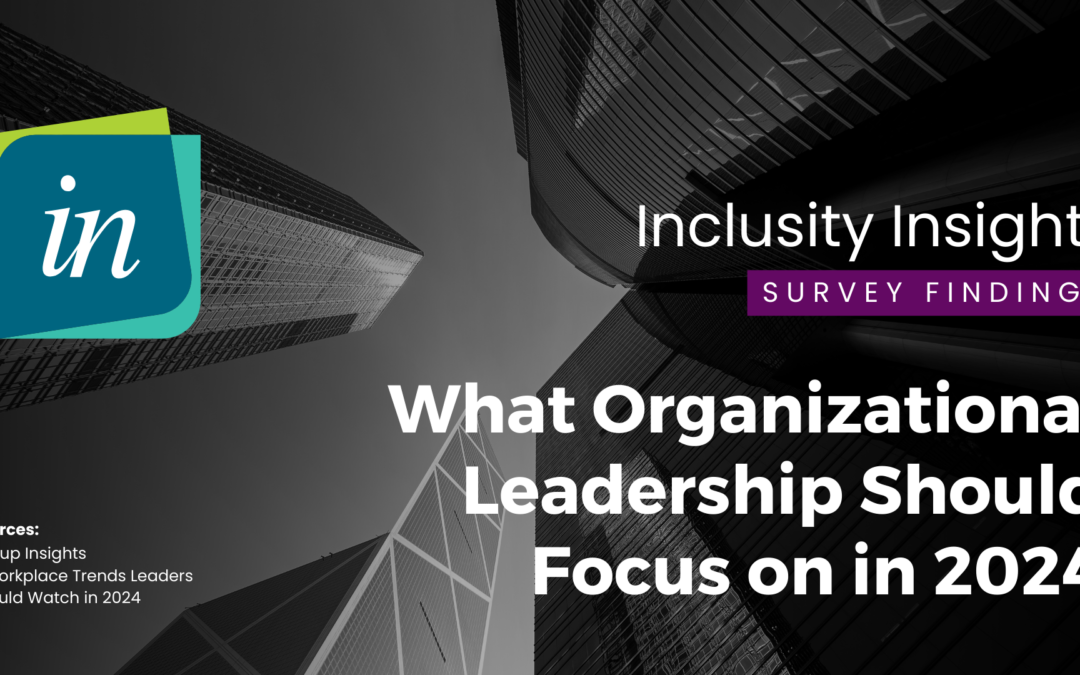
What Organizational Leadership Should Focus on in 2024
The turn of the calendar year often prompts organizations to pause and reflect; it’s an opportunity to assess the previous year and make conscious choices about where to go in the current year. 2023 stood out for concerns about inflation, adjustment to the “new normal” after the pandemic, and a hot labor market with increased turnover and greater demands from employees.
According to Gallup’s “6 Workplace Trends Leaders Should Watch in 2024,” some of these topics will continue to be in focus this year. These trends largely reinforce what we’ve always maintained at Inclusity: In order to maximize effectiveness, organizations must invest in creating an inclusive culture. Reflecting on Gallup’s themes, two specific ideas stand out: navigating a hybrid workplace and re-establishing trust.
Increase Employee Engagement through a Hybrid Culture
Even as COVID cases have ebbed and we have entered a “new normal,” questions about the long-term trajectory of many organizations have been left unresolved. Many employees still wonder if and when they’ll be asked to return to the office full-time. Gallup’s data revealed that many view this prospect with some degree of dread; only 6% of American employees in remote-capable jobs surveyed said that they’d prefer to be fully on-site in the future. Most people tend to think about the preference for hybrid or fully remote options in terms of practicality; employees don’t have to commute, can take care of projects around the house on break time, etc.
At Inclusity, however, we view flexible work arrangements through an inclusive lens. For example, remote work can remove accessibility barriers and better accommodate people who are neurodivergent or juggle caregiving. Remote-hybrid options allow people to be their most authentic selves – especially employees who are marginalized or out-of-the-norm at their organization. People of color who work remote have reported a decrease in microaggressions.
In 2024, we encourage workplaces to definitively throw out the traditional fully on-site model and meet employees where they are. As Gallup and other data show, well-managed fully remote and hybrid employees tend to have higher engagement, higher wellbeing, and lower turnover. At Inclusity, we offer leaders many tools for exactly how to manage these employees well, focusing on how more creative work setups allow for authenticity and engagement.
Building Trust Can Be Transformative
Implementing management skills like inclusive leadership also helps address the other big issues we see in these data: an ongoing lack of trust in organizational leadership and a lack of connection to mission and purpose. The ambiguity about the future of the work environment is only one of many factors that fuel these disconnects. When Inclusity talks to employees across our clients, we regularly hear about leaders failing to take a stand on issues that matter and feeling as though organizational mission and purpose are outdated. The concerns we hear are not just ideological; they add to employee stress, another trend observed in the Gallup data. And of course, the individuals who are most likely to experience these disconnects are those who are out-of-the-norm within their organizations.
At Inclusity, we have seen the incredible transformation that happens when organizational leadership revisits their mission and purpose with an inclusion lens and focus on rebuilding trust with employees. While we see direct benefits such as increased employee engagement and lower turnover, we also see secondary effects that weren’t even considered. For example, when someone experiences a subtle act of exclusion (microaggression) at work, trust turns out to be the factor that most strongly determines how they react. In trusting environments, the target is more likely to see the behavior as unintentional and work to repair the relationship, whereas a lack of trust drives blaming behavior and resentment, further eroding culture.
We’ve developed many tools that help build trust and integrity within organizations. These qualities are not just integral for effective inclusion work; they also have a positive impact on organizational effectiveness and morale overall.
Inclusion is the Answer
Gallup discusses these trends as separate issues to tackle with different strategies. At Inclusity, we see one underlying issue: inclusion. Effective efforts to cultivate an inclusive workplace touch on all these topics and more. Deliberately fostering inclusion increases trust, increases employee engagement, decreases stress, and has a multitude of additional benefits beyond these specific workplace trends. When your organization is ready to take a serious approach to fostering a more inclusive culture, we have the tools, strategies, and insights to get you there.
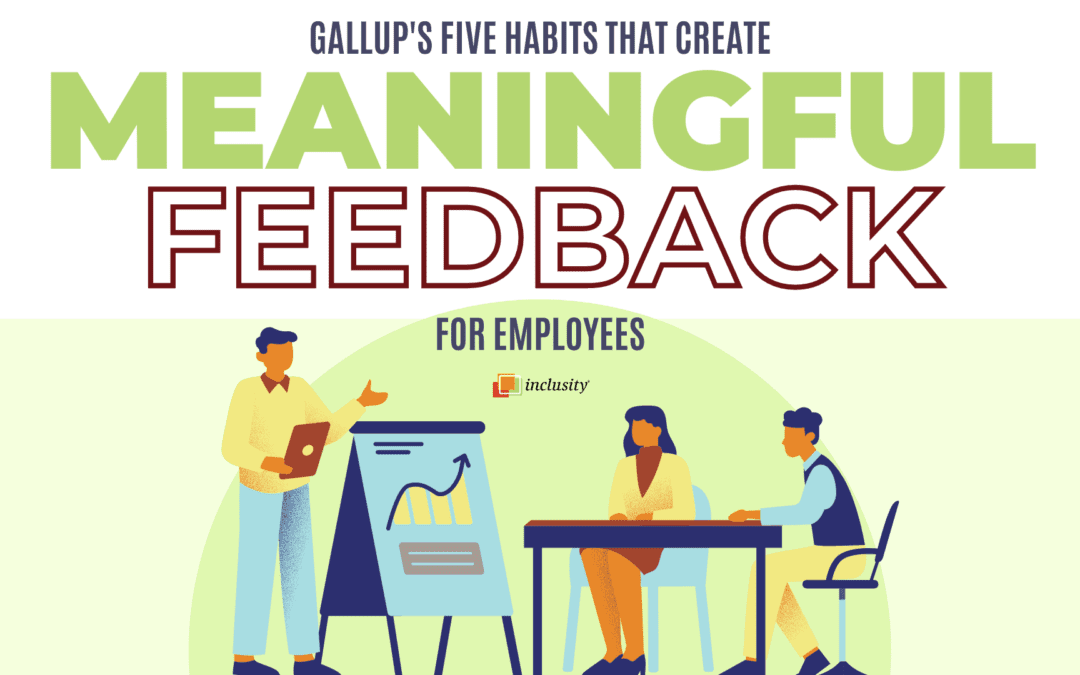
5 Easy Ways to Increase Employee Engagement with Meaningful Conversation
Are you Struggling to Keep your Employees engaged? You’re not alone.
According to a Gallup survey, only 36% of U.S. employees are engaged at work. However, there’s a simple solution – meaningful conversation. Engaged employees are more productive, committed to their work, and more likely to stay with the company.
Why is Employee Engagement Important?
The importance of inclusive and engaged leadership at the highest levels is very closely tied to the engagement of their employees. As we talked about in our last post, highly engaged teams have been proven to have lower absenteeism, higher quality of work, higher profitability, and higher wellbeing. According to research, teams with high engagement have 81% lower absenteeism, 41% higher quality of work, 23% higher profitability, and 66% higher wellbeing than teams with low engagement.
Managers who are supervised by engaged leadership are 39% more likely to be engaged, and employees supervised by engaged managers are 59% more likely to be engaged. However, the same study shows that only 51% of managers and 30% of employees are engaged, costing businesses billions annually (Gallup, 2015).
But what does Employee Engagement have to do with Inclusive Leadership?
Another study by Gallup revealed the most interesting data yet. Respondents were asked: “If you could make one change at your current employer to make it a great place to work, what would it be?” 41% responded in the “Engagement and Culture,” category, far surpassing the next highest responses of “Pay and benefits” (28%) and “wellbeing.” (16%). Many respondents said they would like more recognition, opportunities to learn, fair treatment, clearer goals and better managers (Gallup, 2023). Practicing inclusive leadership will naturally lead to a more inclusive and engaging culture!
Here are five ways to increase employee engagement through meaningful conversation:
1. Recognize and Appreciate Employees
It’s essential to recognize and appreciate employees for the work they do. According to Gallup, only 23% of employees strongly agree that they get the right amount of recognition for their work. Managers should make an effort to recognize and appreciate employees regularly.
2. Facilitate Coworker Relationships
Managers can facilitate connecting the right team partners, whether in-person or virtually. This helps employees build relationships and trust with their coworkers, increasing engagement and productivity.
3. Provide Clarity of Work Expectations
Clarity of work expectations is key for employees to do their best work, but gallup’s poll shows that many employees lack clear direction – especially among younger workers. Managers should provide clear and specific expectations for each employee’s role and responsibilities, including goals and objectives.
4. Have Frequent, Short Conversations
Meaningful conversation does not always have to be long and in-depth. In fact, 15- to 30-minute conversations have a greater impact than 30- to 60-minute conversations, but only if it happens frequently – preferably on a weekly basis. Managers should schedule regular one-on-one meetings with their employees to discuss their progress, challenges, and aspirations.
5. Focus on Employee Strengths
By focusing on employee strengths, managers can help employees identify opportunities for growth and development. They can also assign tasks and projects that align with their strengths, which leads to greater engagement and motivation.
Creating meaningful conversation is a fantastic and simple way to increase employee engagement, and these five habits will make it easy to do so. Remember to recognize and appreciate your employees, facilitate coworker relationships, provide clarity of work expectations, have frequent, short conversations, and focus on employee strengths.
Check out the infographic below for a quick summary!
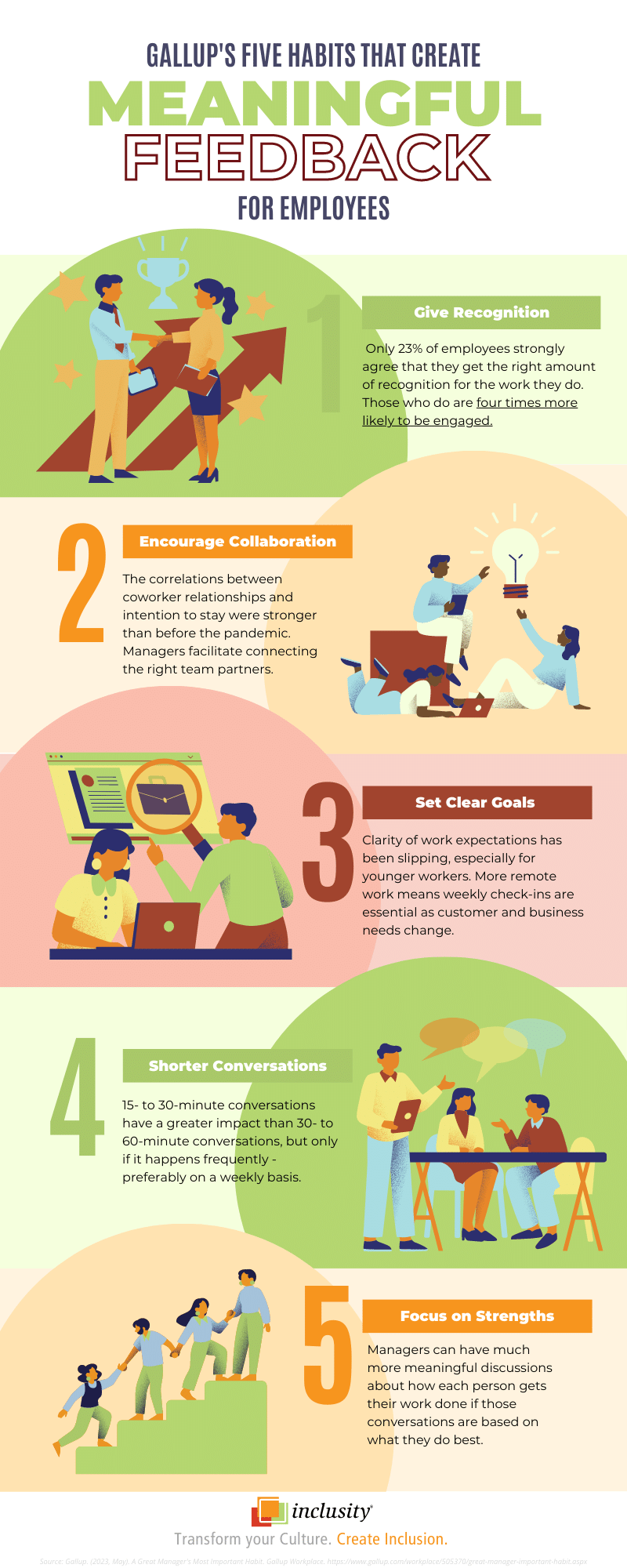
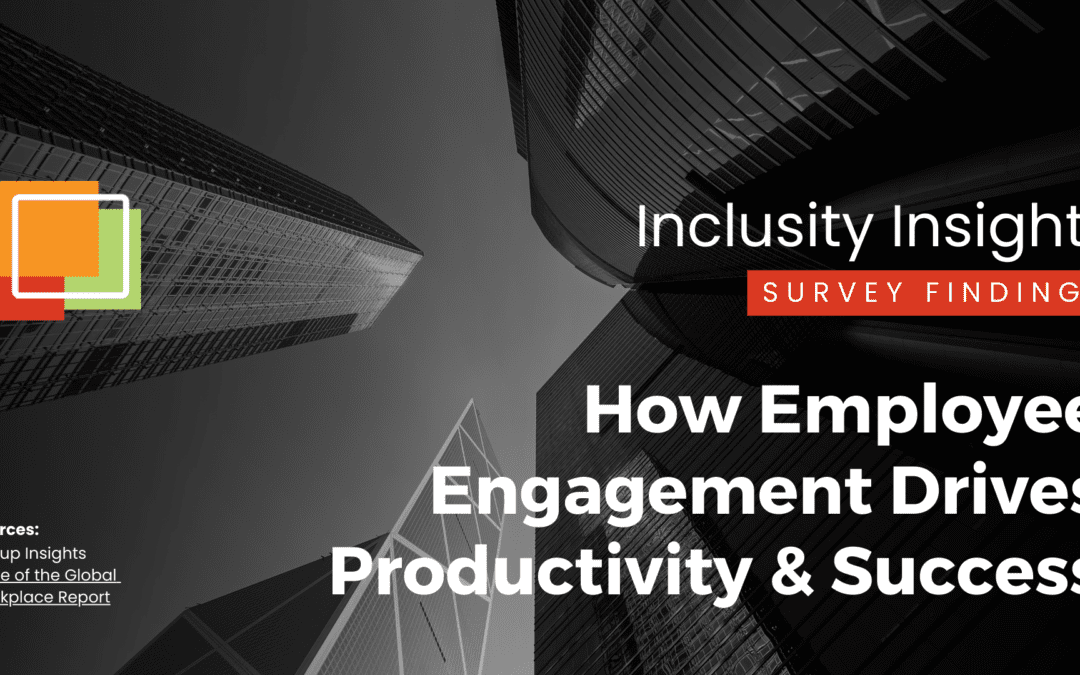
The Importance of Employee Engagement
The importance of inclusive and engaged leadership at the highest levels is very closely tied to the engagement of their employees.
Employee engagement refers the level of commitment and enthusiasm that employees have for their work and the company they work for. When employees are engaged, they are more productive, creative, and loyal. They go above and beyond their job responsibilities to help the company achieve its goals. In this article, we will discuss the findings of Gallup’s Employee Engagement Survey, the importance of employee engagement, and how it can benefit an organization.
Managers who are supervised by engaged leadership are 39% more likely to be engaged, and employees supervised by engaged managers are 59% more likely to be engaged. However, the same study shows that only 51% of managers and 30% of employees are engaged, costing businesses billions annually (Gallup, 2015).
But what does engagement have to do with inclusive leadership? Another study by Gallup revealed the most interesting data yet. Respondents were asked: “If you could make one change at your current employer to make it a great place to work, what would it be?” 41% responded in the “Engagement and Culture,” category, far surpassing the next highest responses of “Pay and benefits” (28%) and “wellbeing.” (16%). Many respondents said they would like more recognition, opportunities to learn, fair treatment, clearer goals and better managers (Gallup, 2023).
Gallup’s study “Gallup Q12® Meta-Analysis” examines decades of employee engagement and performance data from more than 100,000 teams to evaluate the connection between employee engagement and 11 key business outcomes. Below are some exciting and revealing statistics that we felt are important to any business or organization!
Highly Engaged Teams are 23% more profitable and 14% more productive.
Employee engagement leads to increased productivity. Engaged employees are more motivated to work hard and put in extra effort to ensure that their work is of high quality. They are also more likely to stay focused and avoid distractions. This results in higher productivity levels and better performance. In addition, engaged employees are more likely to take on additional responsibilities and learn new skills to further improve their performance.
Highly Engaged Teams have an 81% lower rate of absenteeism and a 43% lower rate of turnover.
Engaged employees are more likely to stay with their current employer because they feel valued and appreciated. They are also more likely to recommend their company to others as a great place to work. This can help to attract and retain top talent, which is essential for the long-term success of an organization.
Highly Engaged Teams have a 10% higher rate of customer loyalty and an 18% increase in productivity in sales.
Employee engagement leads to better customer service. Engaged employees are more likely to provide excellent customer service because they care about the success of the company they work for. They are more willing to go above and beyond to ensure that customers are satisfied with their experience. This can lead to increased customer loyalty and positive word-of-mouth advertising.
Highly Engaged Teams have a 66% higher rate of well-being and a 13% increase in organizational participation.
Employee engagement leads to a more positive work environment. When employees are engaged, they are more likely to be happy and satisfied with their work. They are also more likely to get along with their colleagues and work well together as a team. A higher sense of well-being amongst employees also leads to better participation in organizational citizenship, facilitating change management at every level.
Don’t underestimate the effects of high employee engagement – it can make all the difference!
Need some ideas on how to increase employee engagement? Check out our next post this Thursday: 5 Easy Ways to Increase Employee Engagement with Meaningful Conversation

A Culture of Inclusion Starts at the Top
Building a culture of inclusion begins when leadership is on board. Their commitment is essential to sustaining a positive culture in the long run.
Although the responsibility for inclusion sits on the shoulders of the CEO, the only way for any diversity and inclusion program to survive and be effective is through leadership commitment. When employees see the behaviors and actions of inclusive leaders, they will be more engaged and productive, helping to grow and contribute to a workplace that is inclusive. Now that why know why it’s important, let’s ask the next logical question: how can you promote an inclusive company culture starting from the top?
How to Build a Culture of Inclusion
Build relationships. An inclusive culture requires a solid foundation of trust. By making efforts to authentically connect with employees and ensure psychological safety for them, leaders can build trust. When employees trust their leadership, they are more likely to share exciting and new ideas, as well as offer fresh perspectives that may have otherwise gone unheard.
Own it. Diversity and inclusion are often treated as a single initiative owned exclusively by HR; however, only when leadership steps up to own and drive diversity and inclusion will a company’s diversity and inclusion practices thrive. Leaders should be the first to role model inclusive behavior, and this will allow employees to feel safe enough to do the same.
Hold inclusion training for leaders. Don’t assume that leaders understand what it means to be inclusive; take the initiative and educate them how to cultivate an inclusive culture. Through inclusion training, they can grow emotional intelligence and better understand unconscious bias, giving them the confidence and skills to make fast, efficient and effective decisions as a people leader.
Practice inclusive leadership. Inclusive leaders actively seek out and consider different perspectives to inform their decision-making. This enables them to collaborate more effectively with others, facilitate constructive conversations, give actionable feedback, and act upon the advice of diverse employees. Leaders should be inclusive of the multiple viewpoints, perspectives and styles that are a part of diverse teams. Inclusive leadership makes diversity matter.
Form an inclusion council. One of the first steps you can take toward establishing a more inclusive organizational culture is to establish an inclusion, diversity, and equity (IDE) council/taskforce. These groups can be involved in goal-setting around hiring, retaining and advancing a diverse workforce and in furthering other IDE efforts. Carefully select employees (including leaders) who are not only passionate about building a diverse and inclusive organization, but also have the respect and trust of your people.
Hold leaders accountable. Make inclusion a core value of the organization — not just something you do to “check a box.” Increase accountability by tying a portion of leaders’ bonuses to diversity and inclusion goals. This sends a strong signal that the company takes the goals seriously. It also pushes leaders to be accountable for their behaviors.
Representation matters. Women and people from marginalized groups are still underpaid and underrepresented in higher level positions compared to their white, male counterparts. Employees should see diversity represented in senior leadership. While finding ways to attract diverse leaders is important, an inclusive culture will help retain that diversity.
No diversity and inclusion efforts and initiatives will be successful without buy-in from leadership. As with any culture change, if you want to develop a culture of inclusion, you must start from the top of the organization. Inclusive leadership is the key to not just creating a culture of inclusion; it is one if the most a crucial elements in fostering an innovative and productive workforce. If you’re interested in working with your leadership to foster a culture of inclusion, Inclusity is here to help.


